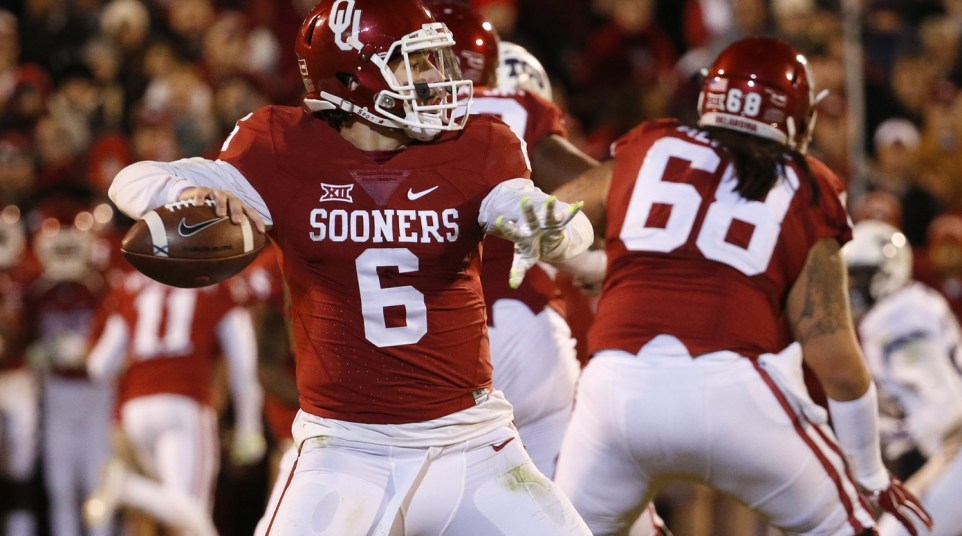
Toughest matchup for Bama if playoff started today
It’s never too early to project College Football Playoff scenarios.
And it’s definitely not too early to project Alabama’s toughest opponent if the Final Four kicked off today.
Iowa, Clemson and Oklahoma are all formidable potential foes. But only one is Alabama’s biggest potential roadblock to a national title.
Which team are talking about? Let’s take a look.
Iowa (11-0): C.J. Beathard, who is 12-0 as a starter, is the very efficient leader of the Hawkeyes’ offense, completing 61 percent of his passes for 2,257 yards, 13 touchdowns and 3 interceptions. But Iowa, behind only Ohio State in the Big Ten in rushing yards per game (208.3), is clearly a ground-oriented team, which plays right into Alabama’s hands.
Beathard is one of four Hawkeyes with 6 rushing TDs. Jordan Canzeri, who ran a school-record 43 times for 256 yards and a touchdown in a 29-20 win over Illinois on Oct. 10, is the Hawkeyes’ top rusher, but an ankle injury has forced him to miss two full games and most of a third. The 5-9, 192-pound Canzeri leads the Hawkeyes in rushing yards (824), TDs (10) and 100-yard games (4).
However, Canzeri isn’t the only Hawkeye with a 200-yard game this season. Akrum Wadley, who burned Northwestern for 204 yards and 4 TDs on 26 carries — all career highs — on Oct. 17, leads Iowa with an average of 6.5 yards per attempt and has two 100-yard games. Junior LeShun Daniels is second on the team with 8 rushing scores and has added 590 yards on 122 carries.
As far as receivers go, Matt VandeBerg is Beathard’s favorite target, and he leads the Hawkeyes in catches (56) and yards (594). But with only 3 receiving TDs and an average of 10.6 yards per reception, he is not a threat to stretch the field.
That distinction belongs to Tevaun Smith, who is averaging a team-best 18 yards per catch on his 24 receptions. Tight end George Kittle leads Iowa with 5 TD grabs.
Even though Desmond King is tied for first in the FBS with eight interceptions, the Hawkeyes are only eighth in the 14-team Big Ten, allowing 214.9 passing yards per game.
They are clearly better against the run, allowing 107.6 yards per game to rank third in the conference and are tied with Michigan for fewest rushing TDs allowed in the league with 7.
In a potential matchup, if the Hawkeyes find a way to shut down Derrick Henry — and so far no team has — Jacob Coker, Calvin Ridley and company should have their way with Iowa.
Clemson (11-0): Like the Hawkeyes, the Tigers have a stud running back in Wayne Gallman, who is second only to Dalvin Cook in the ACC in rushing yards per game (104.3). But QB and potential Heisman candidate Deshaun Watson presents a more difficult challenge.
Watson leads his conference in passing TDs (26) and QB rating (161.08), but he’s also a risk taker; his 10 interceptions trail only Virginia’s Matt Johns for most in the ACC. Watson also ranks 10th in the league in rushing yards per game (58.6).
Eight players have caught at least 13 passes for the Tigers, who are led by Artavis Scott, who has a team-high 74 catches and 680 yards.
Even though it is the second-highest scoring team in the ACC at 38 points per game, Clemson might be better on defense. The Tigers are allowing just 155.4 passing yards per game to lead their league, and they are third in the conference against the run, surrendering 122.8 yards per contest. Clemson is also one of the top pass-rushing teams in the country; the Tigers’ average of 2.91 sacks per game ranks 2nd in the ACC and is tied for 14th in the FBS.
Watson and Clemson are a tough potential foe for Alabama. But one team in the top 4 is an even bigger threat.
Oklahoma (10-1): Like Alabama, the Sooners have a different team since suffering their lone loss of the season. Since falling 24-17 to the Longhorns on Oct. 10, Oklahoma has outscored its past six opponents 306-113 on its way to becoming the Big 12’s top-ranked team.
Like Clemson, the Sooners have a potential Heisman Trophy candidate at QB in Baker Mayfield, who has cleared concussion protocols going into Saturday night’s Bedlam matchup at Oklahoma State. The top-rated signal-caller in the FBS is fourth in the country with 33 TD passes and has thrown just 5 interceptions.
Sterling Shepard is proof that good things come in threes; the Oklahoma wideout is third in the Big 12 in the following categories: catches (69), yards (1,114), TDs (10) and yards per game (101.3).
Plus, the Sooners still have Samaje Perine. The sophomore, who ran for an FBS-record 427 yards against Kansas last year, leads his conference with 13 rushing TDs and is fifth in the league in both rushing yards (1,160) and yards per game (105.5).
But Oklahoma’s defense is the reason it could give Alabama fits. The Sooners are the Big 12’s best in rushing (150.7 yards per game), passing (190.3) and scoring defense (20.5 points per game).
They also lead the conference and are fourth in the country in sacks per game. Plus, say what you want about Bob Stoops, but Oklahoma’s “Big Game” coach is 6-4 against the SEC, including a 45-31 win over Alabama in the Sugar Bowl two seasons ago.
Stoops and the Big 12 might feel disrespected by the rest of the country, but if his Sooners happened to meet Alabama in next month’s playoff, they would give the Crimson Tide its toughest test.
